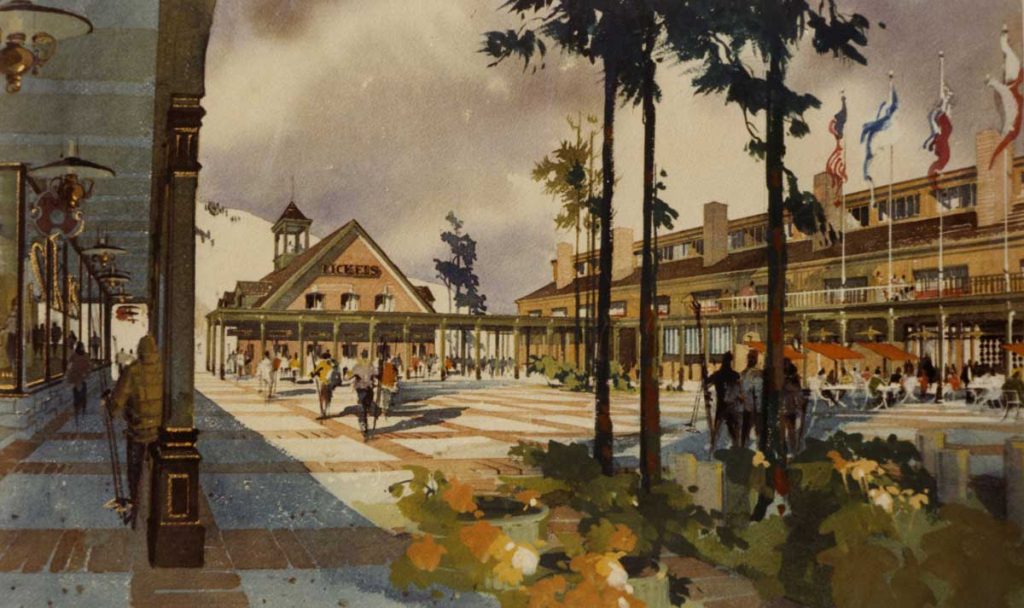Ski season is coming to a close, and while last year marked Park City Mountains’ big 60th anniversary celebration, another anniversary arrived this past November and December. The Resort Village, featuring the Marsac Mill Manor (1325 Lowell Avenue) and Silver Mill House (1355 Lowell Avenue), fully opened for business in mid-November and into December of 1974, joining the Ticket House building (1401 Lowell Avenue), which had already been completed in 1971.
Only the Summit House Restaurant at top of the Bonanza Lift and the old gondola angle station near the base of the Bonanza Lift remain from the original resort that opened in 1963 and pre-date the Resort Village buildings (while the Mid Mountain Lodge has also served Park City in a skiing capacity for 50 years this year – it was home to the United States Ski Team Training Center before it moved to its present location in 1987 – it is also already an historic mining structure).
The Greater Park City Company (G.P.C.C.), chaired by Edgar Stern, bought all 12,000 acres of the Park City Resort in 1970 from United Park City Mines, who had opened Treasure Mountains in 1963. In February 1971, the G.P.C.C developed a master plan for the resort base that included first building a ticket house to host a new ticketing office, ski school operations, and executive offices on second floor. Excavation and construction started summer 1972.
Edgar Stern turned to a close friend from New Orleans, renowned architect Arthur Q. Davis, to design two residential and commercial properties at the Resort Base, which would become Marsac Mill Manor and Silver Mill House. Davis had only recently designed the Louisianna Superdome in New Orleans.
Being from New Orleans, Davis brought a Crescent City flair to the architecture for these two buildings, bringing to Park City the French Revival style of architecture (seen also in 1011 Park Avenue and 1650 Park Avenue). An interesting choice indeed to build a building with a Mansard roof in a town that receives over 350 inches of snow on average each winter. Originally planned to open in November 1973, construction was delayed due to a nationwide steel strike.

Credit: Park City Historical Society & Museum, Edgar Stern Collection
When opened in mid-November 1974, the Marsac Mill Manor and Silver Mill House combined for 28 residential units ranging from studios to three-bedrooms. The Silver Mill House also included a four-bedroom penthouse with its notable steeple on top (in 1974 referred to as the “Tower”), which Edgar Stern originally owned himself.
The ground floor of the buildings originally accommodated twelve commercial properties as well, which hosted a variety of businesses. The November 7, 1974 issue of the Park Record reported that the twelve businesses were to be The Purple Mushroom art gallery, a liquor store, the Corner Store restaurant, and La Retreat Restaurant in the Marsac Mill Manor and a new Dolly’s clothes and bookstore location, an antique store from Randy Kennard, the Treasure Mountain Gallery of art, the Ski Shack repair shop, Stein Erickson’s Ski Shop and High Performance Rentals, the Scott Nelson Photography gallery, a Wolf’s Sportsman’s Headquarters ski rental and repair shop, and The Village Pharmacy drug store.
The Corner Store, of course, is still operating today. The Baja Cantina restaurant also later opened in the Silver Mill House in December 1983, marking 40 years as a business last ski season.
The Resort Village’s historical significance derives from its place in Park City’s reconfiguration from a mining hub to a ski tourism destination (plus a little bit of architectural significance). It is part of what the Park City Museum is considering to be Park City’s “Resort and Community Development Era” from 1963 through 1981, of which buildings built up to through 1975 are now 50 years old (or older), meaning they have age significance in additional to their potential architectural, cultural, and/or economic significance.
These ski era buildings and homes from 1963 to 1975 not only marked a new era, but breathed new life into town. Without these new structures integrating with the old, Park City would not have developed into the recreation and tourism hub it is today, nor would it have the mixed fabric that attracts visitors. Ski era buildings’ existences are just as important to the history of Park City and the town’s development as structures from either the mining boom or mature mining eras are.
But while the Museum recognizes these structures each year with its annual historic preservation ribbon award program, these places do not currently have historic preservation protections from the City and are currently vulnerable to neglect and/or redevelopment.
A portion of this article came from information compiled by Mark Morgan of the Marsac Mill Manor and Silver Mill House HOA.